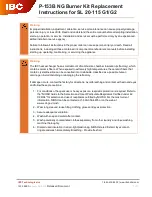
Mode of operation
6
13
6
MODE OF OPERATION
6.1
Feeding system
The fuel is fed from the fuel storage room by the
room discharge system to the burn back
protection device (BFP). Fuel passes the hopper
first, afterwards the back burn flap. The back burn
flap gets steered by a spring loaded servo motor.
If the servo motor operates current less, the back
burn flap will close independently. Next the fuel is
fed towards the burning chamber by the feeding
screw. The achieved fuel level is a crucial factor of
the boiler heat output and operating mode.
6.2
Versions conveyor systems
6.2.1
Version flexible screw system
In this version, the fuel supply with flexible
discharge screw from the storage room. Attached
to the boiler is an insertion screw, which conveys
the pellets obliquely upwards and feeds them by
means of a slide to the combustion. The backfire
protection device (BFP) is located on this feed
screw. This back-fire protection device is opened
by means of a spring return motor. At standstill or
power failure, this engine closes automatically.
The flap provides a fireproof separation between
the feed screw and the discharge screw.
The BFP also requires level monitoring.
The flexible room discharge of the
boiler
consists
of a stored auger including cover in the storage
room area and a flexible auger in the area of the
boiler room. As drive a standard gear motor is
used.
The insertion screw is roughly made up of the
following components:
➢
Stoker screw motor
➢
Fire-resistant device with spring return
motor
➢
Stoker pipe
➢
Feed screw temperature sensor (PT 1000)
6.2.2
Version suction system
In this execution, the fuel is supplied from the
storage room by means of suction probe or a rigid
screw or other sampling systems. This discharge
medium is located in the storage room. Outside
the storage room is sucked by vacuum. This
negative pressure is generated via a turbine,
which is mounted in the pellet boiler.
Before the suction process, the boiler is defined
"burned out" and carried out a rust cleaning. This
means that all the pellets on the grate are
completely burned and the resulting ash is
transported into the ash tray. During the suction
process, the pellets are conveyed via the suction
tube into a separator.
From the storage tank, the pellets are first
transported via the chute with a screw conveyor
including cell wheel. Next the fuel is fed towards
the burning chamber by the feeding screw. These
are then directed to the combustion chamber via a
drop level.
The discharge of the fuel from the fuel storage
room via a screw conveyor. The room extractor is
driven by a gearmotor at the boiler end of the
auger. The auger is as far as possible equipped
with a spiral auger to prevent congestion.
6.2.3
Version hopper for manual filling
In this version, the pellets are manually filled in a
storage hopper. From the storage tank, the pellets
are first transported via the chute with a screw
conveyor including cell wheel. Next the fuel is fed
towards the burning chamber by the feeding
screw. These are then directed to the combustion
chamber via a drop level.
6.3
Feeding type
The operation of the boiler is based on a pulse-
no-pulse ratio, which controls the feeding system.
All the values are to be set via the menu “Fuel
values” (only available in the service area). These
feed values are corrected by the combustion
control system.
6.4
Combustion air control
The supplied combustion air is differentiated
between primary and secondary air. The primary
air is initiated directly into the embers. The
secondary air gets used to actuate the developed
flame to a completely. The air supply is piped via
vents on the burner side (underneath side cover).
The flue gas ventilator is a suction fan and this is
located at the back of the boiler. It generates low
pressure in the boiler. The secondary- and
primary air get sucked out due low pressure.
The ID-fan is time-controlled by the variable-
speed electronic control. The ID-fan speed is
controlled according to the boiler temperature and
rectified by the lambda control.
6.5
Boiler operation
The boiler starts up automatically with its built-in
automatic ignition, when heat is required.
The heat requirement can be controlled by the
weather or by a remote sensor (optional),
depending on any heating circuit. A room
thermometer can also be used to generate an
external requirement. The boiler can also be
started up by the requirement of a hot water tank.
The boiler output can be controlled by set up
values and adjusted to local conditions.
Too high boiler temperatures are not permissible.
Содержание pelletstar CONDENSATION 10
Страница 1: ...OPERATING INSTRUCTIONS Pellet boiler pelletstar CONDENSATION 10 60 ...
Страница 20: ...8 Temperature manager 20 Fig 8 6 Example temperature manager when time mode without difference ...
Страница 85: ...Annex 15 85 15 ANNEX 15 1 Additional boiler schematic visualization Hydraulic recommendation 1 ...
Страница 86: ...15 Annex 86 Hydraulic recommendation 2 ...
Страница 87: ...Annex 15 87 15 2 Solar module schematic representation Program 1 ...
Страница 88: ...15 Annex 88 Program 2 ...
Страница 89: ...Annex 15 89 Program 3 ...
Страница 90: ...15 Annex 90 Program 4 ...
Страница 91: ...Annex 15 91 Program 5 ...
Страница 92: ...15 Annex 92 Program 6 ...
Страница 93: ...Notes 16 93 16 NOTES ...














































